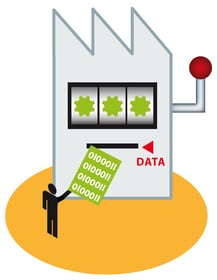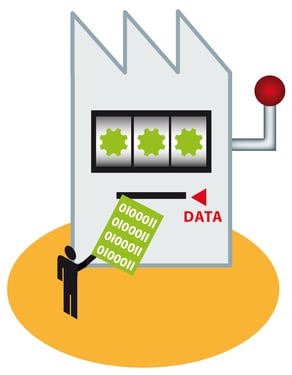What Is Data-Driven Manufacturing?
Brian Hoey - October 08, 2019

 Right now, even if your factory is relatively well equipped with IoT devices and RFID chips that can send production information back to your control tower, there’s a good chance that you’re still relying heavily on time-triggered events as your products make their way across the production floor. Sure, you’re gathering data at various stages of the production process, but that data isn’t automatically causing anything to happen. If something seems to be going catastrophically wrong, a production planner might get an alert and perform some manual triage, but most of the time the data functions as something of a post-mortem.
Right now, even if your factory is relatively well equipped with IoT devices and RFID chips that can send production information back to your control tower, there’s a good chance that you’re still relying heavily on time-triggered events as your products make their way across the production floor. Sure, you’re gathering data at various stages of the production process, but that data isn’t automatically causing anything to happen. If something seems to be going catastrophically wrong, a production planner might get an alert and perform some manual triage, but most of the time the data functions as something of a post-mortem.
Though the process we’re describing incorporates data, could we really describe it as data-driven? In a sense, not really—because data isn’t specifically driving any actions within your production chain. If, by contrast, you were able to reconfigure your production line such that some events that used to be time-triggered were event-triggered instead, you could more reasonably argue that your processes were really driven by data. Why? Because incoming information on your IoT devices would, for instance, automatically alert your inventory management system that it was time to pick the next pallet worth of product, rather than letting that pallet come in and out on a regularly timed schedule and potentially arriving too early or too late.
This is just one of the myriad ways in which data can be more actively incorporated into the value chain, and it represents an exciting path forward in the coming era of Industry 4.0.
Generating Data
Okay, let’s back up a step and more directly answer the critical question: What is data-driven manufacturing, and how can you make it reality within your value chain? Basically, being data-driven means that whenever your make a decision, whether that’s setting production ratios for different products based on forecasted demand or reorganizing your factor floor to optimize the flow of resources, that decision is based on a large quantity of relevant information. It follows, then, that the first step in going data-driven is to find and harness all of the data sources at your disposal.
Like we alluded to above, this might mean implementing internet of things (IoT) devices throughout your factory floor, but it’s also a matter of creating data transparency within your larger IT infrastructure. If, for instance, your order fulfilment system doesn’t connect to your ERP platform in such a way as to enable data sharing, you’ll end up with data silos that make a complete picture of your supply chain impossible. Once those silos are taken care of, however, you can begin to pull in information not just from processes that you can monitor directly, but other touchpoints on the value chain, including data from your suppliers and even your customers. The more information sources you can integrate into your planning flows, the more powerful your existing data will become.
As a potential starting point, you might consider developing a Postmodern ERP mindset, i.e. working to adopt software that can interconnect with your existing infrastructure. This way, you can ensure data visibility without mandating that everyone use the same particular piece of software for their disparate functions.
Putting Data to Use
Once you’re collecting data and making it visible cross-functionally, you’re finally in a position to incorporate data into your daily decision-making in a meaningful way. This can, of course, look like the kinds of relatively automated workflows that we saw above (with event triggered supply chain activity), but it can also center on empowering human decision-makers in the moment. Envision, for instance, a sales and operations execution (S&OE) workflow, in which a planner turns real-time demand and transport information into minute daily supply chain adjustments: the S&OE planner isn’t just looking at a few Gantt charts and making leisurely decisions—she’s adding value through real-time data monitoring, and then offering a snapshot of changing demand conditions that S&OP planners can consult before finalizing longer-term plans.
Ultimately, workflows like these come to form the basis of Industry 4.0. This can include a certain amount of automation—like inventory levels not just stabilizing via their own networked workflows, but also self-adjusting to optimal levels of different parts based on past buyer behavior; or production processes that identify and adjust to slowdowns on the fly. These sorts of innovations might seem like they’re a long away off, but less complex manifestations of data-driven manufacturing are already cropping up. A large automaker might use accumulated customer orders to better forecast future demand, making adjustments to raw material ordering and warehouse space allocation accordingly. By the same token, you might see a manufacturer selling products that require a lot of customization using machine-learning to predict likely combinations to prepare to fulfill custom orders before they even materialize.
Challenges to Going Data-Driven
Based on what we’ve been describing above, data-driven manufacturing seems like an obvious way for modern manufacturing outfits to reduce waste, increase efficiency, and ultimately add value in the Industry 4.0 era. If that’s the case, why isn’t everyone rushing to their nearest IoT device vendor? Well, in point of fact, plenty of people are—it’s just that a few devices incorporated into your production plant doesn’t automatically yield truly data-driven supply chain management. Rather, there are a number of challenges and hurdles that can make data-driven workflows difficult or impossible to achieve:
- Information silos
- Planning silos
- Lag between data intake and availability
- Legacy IT infrastructure
- Reactive or non-adaptive planning cycles
- Lack of supplier integration
- Disconnect between different business functions
Take a hard look at your own manufacturing operation: are you susceptible to any of these issues? If so, you may have to do some work to collect data and turn it into usable business insights. This might seem daunting, but it’s almost certainly worth the effort. Whatever investment you put into resolving these issues will go towards creating new, value-additive frameworks for maker smarter decisions, faster. At the end of the day, isn’t that exactly what defines successful supply chain management?
LATEST POSTS
- Understand Why Production Planning Needs Specialized Solutions
- Understand Circular Economy in The Manufacturing Industry
- How Can Industry 4.0 IT Integration Be Achieved Smoothly?
- The Significance of Order Sequencing in Discrete Manufacturing
- How to improve your Supply Chain Management: The Power of Control Towers



